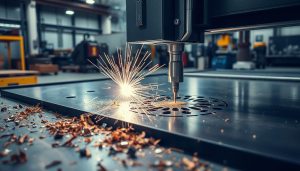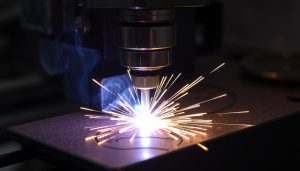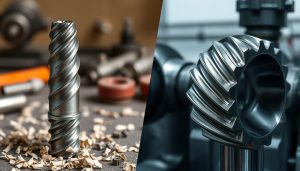In the realm of manufacturing, sand casting stands as a cornerstone technique that has shaped the production of complex metal components for centuries. This foundational metal casting process utilizes sand molds to create a wide array of parts, from intricate automotive parts to robust industrial equipment. As a versatile and adaptable method, sand casting has remained a crucial manufacturing process, continuously evolving to meet the demands of modern industries.
At the heart of sand casting lies the ability to transform molten metal into intricate and functional forms. By pouring the liquid metal into a prepared sand mold, manufacturers can create components with remarkable precision and detail, unleashing the potential of metal as a versatile and durable material. The sand casting process not only allows for the production of large-scale items but also enables the creation of small, intricate parts with exceptional accuracy.
As the article delves into the intricacies of sand casting, readers will gain a comprehensive understanding of this foundational manufacturing technique. From the historical evolution of sand casting to its modern-day applications, this exploration will uncover the versatility and significance of this essential metal casting process in the world of manufacturing.
What is Sand Casting?
Sand casting is a versatile metal casting process that has been utilized for centuries. At its core, sand casting involves creating molds from sand and pouring molten metal into them to form the desired shapes and metal components. This age-old technique has evolved over time, adapting to technological advancements while maintaining its fundamental principles.
Introduction to the Sand Casting Process
The sand casting process begins with the creation of a pattern, which serves as a model for the desired part. This pattern is then used to create a mold, typically made from compacted sand. Once the mold is ready, the molten metal is carefully poured into the mold, filling the cavities and taking the shape of the desired sand molds. After the metal cools and solidifies, the casting is removed and undergoes finishing touches to ensure the final product meets the required specifications.
Types of Sand Used in Sand Casting
- Silica sand: The most commonly used type of sand in sand casting, known for its high heat resistance and availability.
- Olivine sand: A specialized sand type that offers improved thermal properties and is often used for complex or high-precision castings.
- Chromite sand: Utilized for casting components that require high-temperature resistance, such as those found in the aerospace industry.
History and Evolution of Sand Casting
The origins of sand casting can be traced back to ancient civilizations, where it was used to create various metal objects, from tools to decorative items. Over the centuries, the process has undergone significant advancements, with the introduction of new sand types, improved mold-making techniques, and the integration of modern technologies. Today, sand casting remains a widely used casting process in a variety of industries, from automotive to aerospace, due to its versatility, cost-effectiveness, and ability to produce complex metal components.
“Sand casting is a versatile and cost-effective metal casting process that has stood the test of time, adapting to the demands of modern industries.”
The Sand Casting Process
The sand casting process is a critical step in transforming raw materials into functional products. This multifaceted approach involves several key stages, each requiring precision and expertise to ensure high-quality results. Let’s delve into the intricacies of this captivating process.
Step 1: Creating the Mold
The first step in the sand casting journey is the creation of the mold. Skilled craftsmen carefully pack sand into a flask, forming a hollow cavity that will serve as the blueprint for the final casting. The mold creation process is a true testament to the art of mold creation, as it lays the foundation for the subsequent steps.
Step 2: Pouring the Metal into the Mold
Once the mold is ready, the next step is to introduce the molten metal. This is where the molten metal pouring stage comes into play, as the craftsmen carefully pour the liquid metal into the prepared cavity. This delicate process requires meticulous timing and temperature control to ensure the metal flows seamlessly into every nook and cranny of the mold.
Step 3: Cooling and Removing the Casting
With the metal now in the mold, the casting must be allowed to cool and solidify. This casting removal stage is a crucial step, as it ensures the final product retains its desired shape and structural integrity. Once the metal has hardened, the mold is carefully broken away, revealing the completed casting.
Step 4: Finishing and Inspection
The sand casting process doesn’t end with the removal of the casting. Skilled technicians must carefully inspect the final product, identifying any imperfections or defects. This stage may also involve additional finishing touches, such as polishing or machining, to ensure the casting meets the highest quality standards.
The sand casting process is a testament to the ingenuity and craftsmanship of metal fabrication. By mastering each step, from mold creation to molten metal pouring and casting removal, manufacturers can produce high-quality, durable castings that serve as the foundation for a wide range of industries.

Advantages of Sand Casting
Sand casting is a highly versatile metal casting process that offers numerous advantages to manufacturers and industries. One of the key benefits is its cost-effectiveness, making it a preferred choice for both large production runs as well as small batches. The process allows for the creation of complex shapes and sizes that might be challenging to achieve with other casting methods.
Furthermore, sand casting accommodates a wide range of materials, including ferrous alloys like iron and steel, as well as non-ferrous options such as aluminum and copper. This material diversity enables manufacturers to meet a wide range of product specifications and design requirements.
- Cost-effective for large and small production runs
- Ability to cast complex shapes and sizes
- Versatility in the range of materials that can be used
“Sand casting is a versatile and cost-effective process that allows us to bring innovative product designs to life across a variety of industries.”
The flexibility and cost-effectiveness of sand casting make it a preferred choice for many manufacturers, enabling them to create high-quality, custom-tailored products that meet their specific needs.
Applications of Sand Casting
Sand casting is a versatile metal casting process that finds extensive applications across various industries. From the automotive sector to aerospace and general manufacturing, this technique plays a crucial role in producing a wide range of components and parts.
Automotive Industry: Engine Blocks and Parts
In the automotive industry, sand casting is a vital process for manufacturing engine blocks and other critical components. The ability to create complex shapes and sizes makes sand casting an ideal choice for producing engine parts that require intricate designs and precise specifications. Automotive components such as cylinder heads, transmission housings, and brake calipers are commonly produced using this casting technique.
Aerospace: Critical Components and Structural Parts
The aerospace industry relies heavily on sand casting for the production of aerospace parts and critical structural elements. The high-precision and reliability of sand casting make it a preferred method for manufacturing components that require exceptional performance and safety standards. Aircraft components like landing gear, turbine blades, and engine mounts are often created using this casting process.
General Manufacturing: Industrial Equipment and Tools
Beyond the automotive and aerospace sectors, sand casting is extensively used in general manufacturing for the production of industrial equipment and tools. From heavy machinery components to power tools and agricultural equipment, this casting technique enables the creation of a diverse range of products that cater to various industrial and commercial needs.
| Industry | Sand Casting Applications |
|---|---|
| Automotive | Engine blocks, cylinder heads, transmission housings, brake calipers |
| Aerospace | Landing gear, turbine blades, engine mounts, structural components |
| General Manufacturing | Heavy machinery parts, power tools, agricultural equipment |
Sand casting’s versatility, cost-effectiveness, and ability to produce complex shapes make it a valuable asset across a wide range of industries, from automotive and aerospace to general manufacturing. This casting technique continues to play a crucial role in the production of essential components and parts that power our modern world.

Challenges in Sand Casting
While sand casting is a versatile and cost-effective metal casting process, it faces several challenges that need to be addressed. Maintaining mold integrity and preventing casting defects is a critical concern, as any imperfections in the mold can lead to flaws in the final product. The post-casting cleaning and finishing processes can also be labor-intensive and time-consuming, adding to the overall complexity of the operation.
Mold Integrity and Potential Defects
One of the primary challenges in sand casting is ensuring the integrity of the mold. Any cracks, voids, or irregularities in the mold can result in a variety of casting defects, such as porosity, shrinkage, and inclusions. These defects can significantly impact the quality and performance of the final product, making it crucial to carefully monitor and maintain the mold throughout the casting process.
Post-Casting Cleaning and Finishing
After the casting is removed from the mold, it often requires extensive cleaning and finishing work to remove any excess material, smooth out the surface, and achieve the desired aesthetic and functional properties. This post-casting process can be labor-intensive and time-consuming, adding to the overall cost and complexity of the sand casting operation.
Material Waste and Environmental Concerns
Sand casting, like many other metal casting processes, generates a significant amount of material waste, including used sand, excess metal, and other byproducts. Disposing of this waste in an environmentally responsible manner can be a challenge, and companies must consider the impact of their sand casting operations on the environment. Addressing these concerns through sustainable practices and technologies is crucial for the long-term viability of the industry.
“Addressing the challenges in sand casting is crucial to improving the efficiency and sustainability of this widely used metal casting process.”
Innovations in Sand Casting
The sand casting industry is embracing a wave of innovative advancements, driving the adoption of automated casting processes and the development of eco-friendly “green casting” techniques. These transformative changes are enhancing efficiency, sustainability, and the industry’s overall competitiveness.
Automation in Sand Casting Processes
Automated casting is revolutionizing the sand casting industry, improving precision and productivity across various stages of the process. From automated mold assembly to robotic pouring and extraction, the integration of advanced technologies is streamlining operations and reducing manual labor. These automated casting systems are empowering manufacturers to achieve greater consistency, faster turnaround times, and enhanced quality control.
Advances in Sand Recycling and Green Casting
Sustainability has become a key priority for the sand casting industry, and advancements in sand recycling and “green manufacturing” are addressing environmental concerns. Innovative sand reclamation techniques allow for the reuse of foundry sand, minimizing waste and reducing the industry’s reliance on virgin materials. Furthermore, the development of green casting methods, such as low-emission melting and eco-friendly binders, are further enhancing the environmental friendliness of sand casting operations.
“The sand casting industry is embracing a wave of innovative advancements, driving the adoption of automated casting processes and the development of eco-friendly ‘green casting’ techniques.”
These technological advancements and sustainable practices are shaping the future of the sand casting industry, delivering increased efficiency, reduced environmental impact, and a more competitive landscape for manufacturers.
Shixinproto’s Sand Casting Solutions
At Shixinproto, we offer comprehensive sand casting services that cater to diverse industries. Our team of experts leverages years of experience and cutting-edge technology to deliver high-quality castings tailored to our clients’ specific needs. Whether you require large-scale production or custom solutions, Shixinproto is your trusted partner in the world of sand casting.
Precision, efficiency, and innovation are the cornerstones of our approach. We understand the importance of reliable and cost-effective manufacturing solutions, which is why we continually strive to optimize our sand casting processes. From creating intricate molds to ensuring meticulous finishing, our commitment to excellence is reflected in every aspect of our work.
Shixinproto’s sand casting services span a wide range of industries, including automotive, aerospace, and general manufacturing. We take pride in our ability to handle complex shapes and sizes, ensuring that our clients can bring their visions to life with confidence. With a focus on quality and customer satisfaction, we are poised to be your partner of choice in the world of sand casting.





